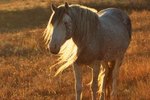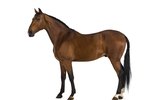A dun is not a specific breed of horse, though most duns have shared lineage somewhere in their bloodlines. The dun coloration is believed to be the result of a genetic dilution gene that affects the coat color of foals. A wide assortment of variations on dun coloration exist. The International Buckskin Horse Association is a color-based breed registry that allows the owners of dun and buckskin horses to register their animals based on color.
Dun Characteristics
The easiest way to spot a true dun is to look for the dorsal stripe on his back and striping on the legs, similar to what you might have seen on a prehistoric horse or a zebra. All true duns will have the dorsal stripe going down the spine from the mane through the base of the tail. Dun coloration can occur on top of almost every other coat color.
Dun Variations
The dun gene works similarly to a cream gene and it dilutes the colors of the horse by lightening them. A chestnut with the dun gene will lighten up to become a red dun. A yellow dun is created by mixing the gene for a bay coat with that for a dun. Dun on black produces a grulla. When a dun breeds with another dun there is an increased likelihood of the foal being an albino, therefore this practice is discouraged.
Registering a Dun
Dun horses can normally be registered with whatever breed association their parents were registered with. For example, if you breed a bay American quarter horse to a dun American quarter horse, then the foal will be both a dun and a registered quarter horse. In addition to being eligible for AQHA registration, the foal is also eligible for registration with color breed associations, such as the International Buckskin Horse Association. Foals that can be registered with multiple organizations are known as double registered or even triple registered horses.
Dun Or Buckskin
Duns and buckskins have similar traits and can be confused with one another. Buckskin horses have the cream dilution gene rather than the dun dilution gene. They also lack the dorsal stripe down the spine. A horse cannot be both a buckskin and a dun.
References
Writer Bio
Jen Davis has been writing since 2004. She has served as a newspaper reporter and her freelance articles have appeared in magazines such as "Horses Incorporated," "The Paisley Pony" and "Alabama Living." Davis earned her Bachelor of Arts in communication with a concentration in journalism from Berry College in Rome, Ga.





